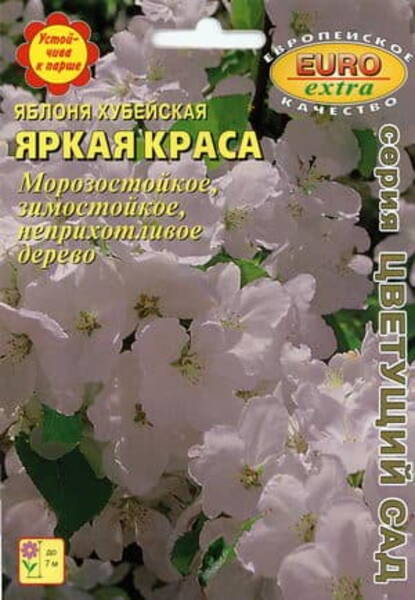This apple tree will delight you with its carmine buds and delicate pink flowers even when all other apple trees have finished blooming (from the end of May). The tree is up to 8 m high with a spherical crown and long branches. Oval bright red fruits, up to 8 mm in diameter, remain on the branches for a long time, sometimes until there is a stable snow cover. They make excellent aromatic jam, compotes and marmalades, they can be dried and put in pies. The Hubei apple tree looks great in gardens and squares, in hedges, in single and group plantings. Agricultural technology: Apple trees prefer sunny places and do not like stagnant moisture. They are propagated by sowing seeds, with spring sowing - stratification from December until sowing with removal at the end of the stratification period under the snow. The apple tree is planted in a permanent place at the age of 2-3 years. Further care consists of fertilizing, pruning and covering young plants for the winter.
Very decorative both during the flowering period and in the fall in fruits. Can be used not only for single and group plantings, but also for planting along roads.
Homeland - central and western China. Grows on mountain slopes. The tree is up to 8 m tall. The leaves are round-ovate with a sharply pointed top, reddish when blooming, almost entire along the edge, about 7 cm long and 5.5 cm wide. Downy on the underside, mainly along the veins, bare on the upper side. Petiole up to 2 cm long with awl-shaped stipules. Flowers when blooming are carmine, then white, large, up to 6 cm in diameter, collected in inflorescences of 3-5 pieces. The fruits are spherical, 1.0-1.3 cm in diameter, greenish-yellow with a burgundy side. It belongs to the late-flowering species. The crown is spherical with long branches. It is beautiful due to its carmine buds. The flowers are pale pink. It finishes flowering at the end of May. It is also decorative during the fruiting stage. Oval bright red fruits, up to 8 mm in diameter, remain on the branches for a long time, sometimes until there is a stable snow cover. It has long been a component of the landscape in the parks of China. In northern conditions, it is resistant to scab, and is quite winter-hardy. It easily tolerates pruning and shearing. It is undemanding to soils. Among deciduous trees, apple trees belong to the group of low trees - their average height is 7-8 meters. A single-row coulisse of apple trees reduces the wind speed in the ground layer by 33%. Apple tree plantings retain snow well - its height under apple tree protection is 2 times higher than without it.
A little history.
The history of apples begins with the wild apple tree (Pyrus malus).
It probably originates from Central Asia: southern Kazakhstan, Kyrgyzstan, Tajikistan.
All varieties of apple trees cultivated today originated from the wild apple tree. It served as a rootstock on which new species were grafted. The wild apple tree is found in most countries and regions of Europe, from Norway to the Caucasus.
The concept of "low decorativeness" is not applicable to any apple trees, but cultivated large-fruited varieties cannot compete in diversity and level of decorativeness with their wild relatives. The chief gardener at the Imperial Forestry Institute E. L. Wolf in the book "Decorative Shrubs and Trees for Gardens and Parks", published in 1915, gives an enthusiastic description of the decorative qualities of wild apple trees: "Decorative apple trees seem to be breaking under the weight of their fabulous floral splendor of attire, there is not a single branch that would not be shrouded in floral snow. There is no more durable and richly flowering decoration for the garden." The life cycle of cultivated apple trees is 45-50 years, and 65 years for wild ones. In nature, the age of wild apple trees reaches 80 years. The flowers of wild apple trees are very fragrant. During mass flowering, pleasant smells spread over a considerable distance and attract many insects. But it is known that fragrant plants not only have a beneficial effect on humans, but also have great sanitary and hygienic significance - it has been proven that they are powerful antibiotics.
The budding stage of an apple tree is one of the most colorful, since the color of the buds is much brighter than that of the flowers. The simultaneous presence of buds of varying degrees of formation on the branches and, as a result, of different color intensity creates a unique colorful effect. The budding stage significantly extends the flowering phase (and flowering in wild apple trees is very abundant).
A significant indicator when assessing the decorativeness of a plant is the fruiting phase. In wild apple species, it is quite extended in time (more than a month). In many small-fruited forms, the fruits remain on the branches even after the leaves have fallen. Fruiting itself is also abundant, and the size, shape, and color of the fruits are very diverse.











